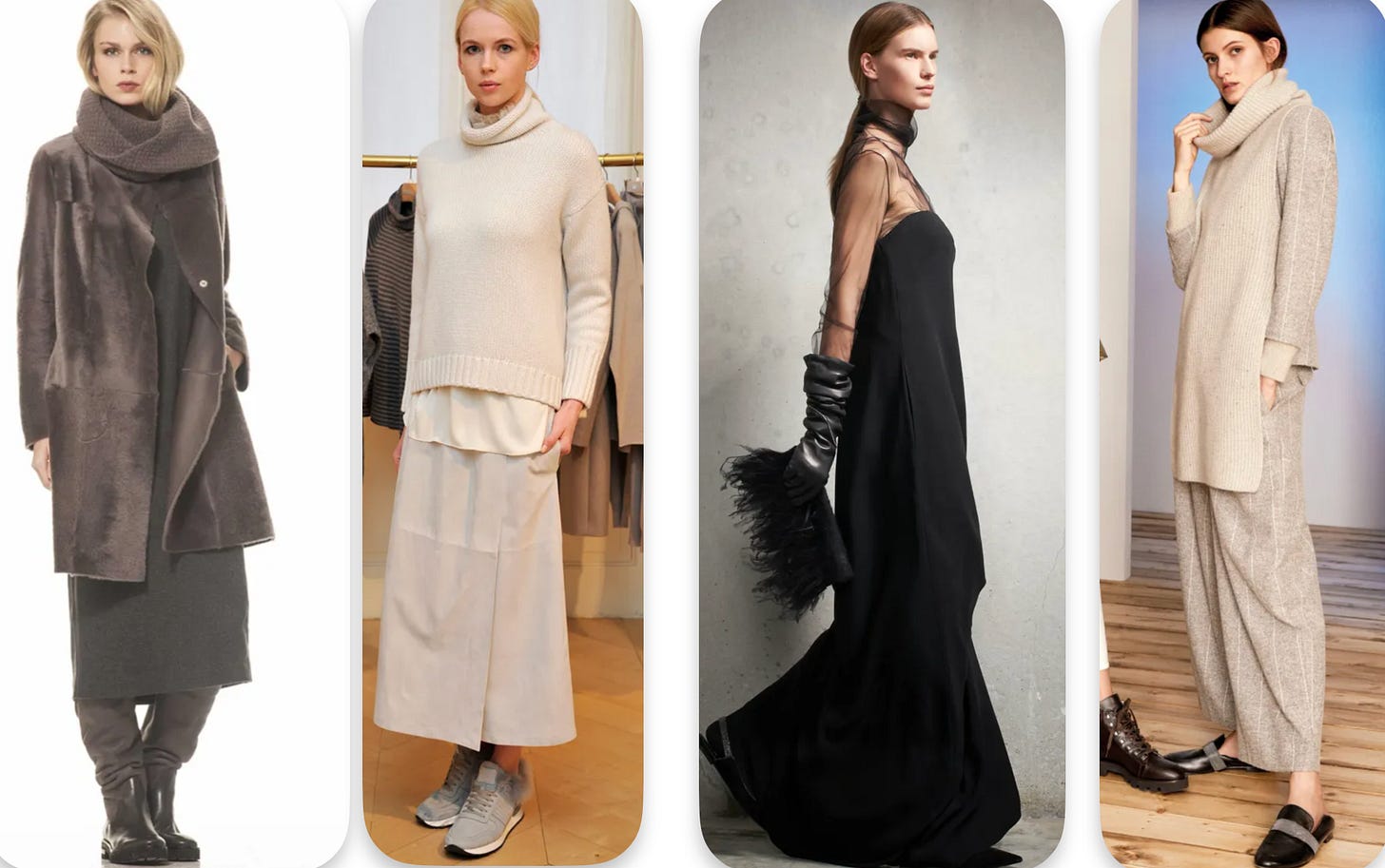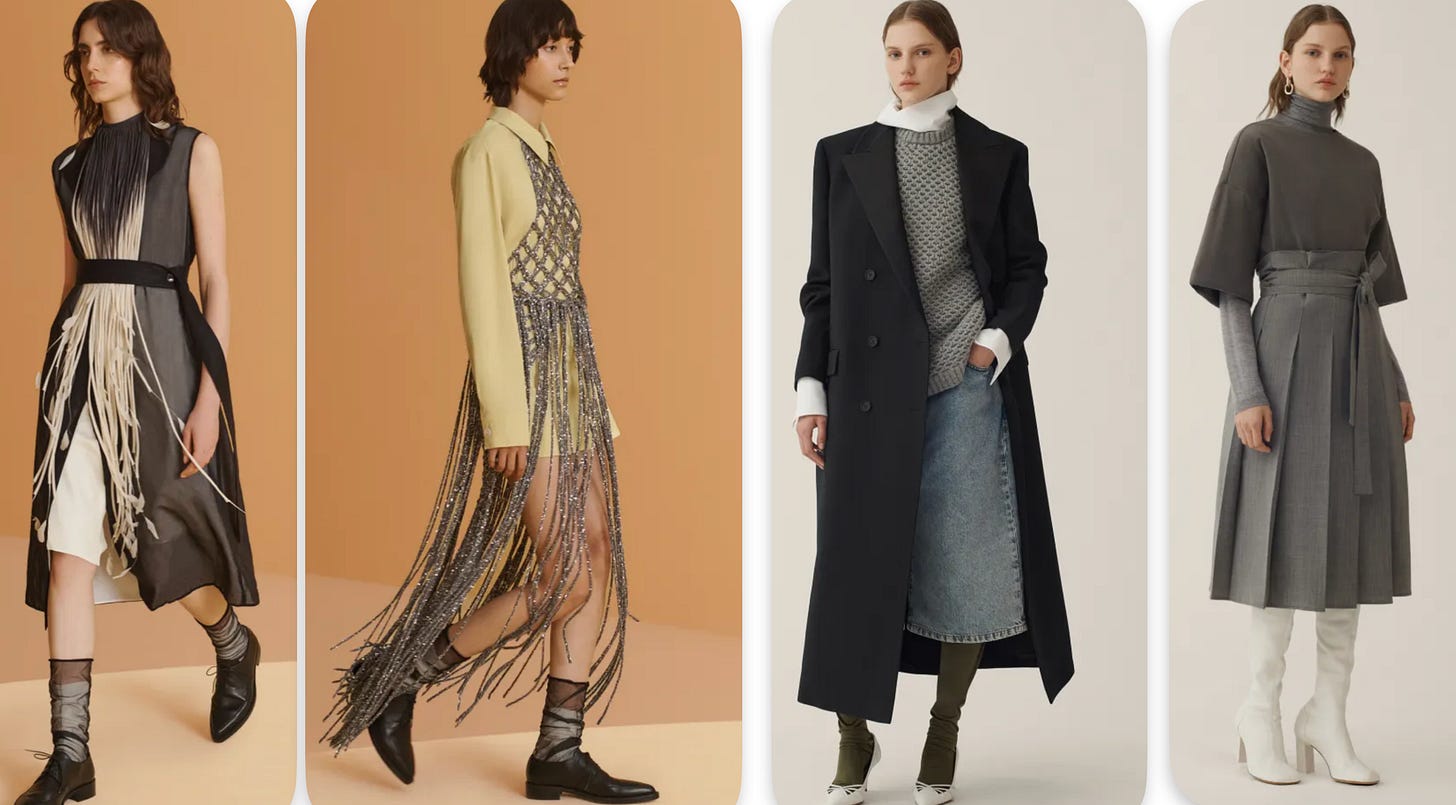Fabiana Filippi | From Brunello Cucinelli’s Classic Elegance to Jil Sander’s Minimalism, with Cashmere Almost Abandoned
Fabiana Filippi was founded in 1985 in Umbria, Italy, by brothers Mario and Giacomo Filippi Coccetta. Initially, the brand aimed to provide elegant cashmere knits and cashmere coat collections for women. After 2023, both the CEO and creative director of the brand changed, and the style shifted from a cashmere-focused brand to a minimalist one. In terms of clothing design, since Spring 2022, the brand has completely changed. Cheaper fabrics such as denim, cotton, wool, and polyester began appearing, whereas previously it was all about fur, silk, and cashmere.
Currently, Fabiana Filippi is in a market expansion phase. In 2023, Aldo Gotti, who previously held an executive role in the France and Monaco regions at the Prada Group, was appointed as the CEO. He is focusing primarily on the European market and has established a new headquarters in New York, with a strong emphasis on the Chinese market, which is mainly sold through SKP and Lane Crawford in China.
In 2023, Lucia De Vito, who had previously worked at Chloé, Jil Sander, and Valentino, became Fabiana Filippi's first creative director. She reports directly to the Group CEO, Aldo Gotti, and released her first collection in September 2023.
As a result, Fabiana Filippi now represents a revamped brand. It is more modernized, with a drop in fabric quality. The most representative items are no longer the cashmere coat knits the brand once focused on, but instead wool coats, suits, and trousers. There are also synthetic fabrics like polyester now used.
Most of the pricing is similar to Armarium and La Collection (maybe a little higher) , positioning the brand in the mid-high-end minimalist category. There are still a small number of cashmere coats and fur items priced similarly to Akris and The Row, but overall, due to the brand's downgrade, prices are lower, and the variety of garments with lower-quality fabrics has increased. The brand now has a wide price range, with coats ranging from 10,000 RMB to 70,000 RMB, which can be a bit confusing.
Although some designs still showcase noticeable craftsmanship in terms of fit and structure, the fabric quality has dropped, and the design features that Fabiana Filippi was known for are disappearing. I feel it's a shame and I am not very optimistic about it. The brand has shifted from a solid cashmere label to a minimalist brand under the control of capital groups.
This article attempts to cover the design features of Fabiana Filippi's early years and its Lookbooks from the BC period. The transformation after 2022 is still something I’m observing. The Prada Group may have realized that it’s not profitable, and it may be sold again. Perhaps, like Malo the brand will return to its cashmere roots.
I think Fabiana Filippi's original designs were even more attractive than Agnona. It seems to me that the marketing hasn't really taken off. The two founders were relatively laid-back, with BC’s annual Lookbook featuring 20-30 new pieces, while Fabiana Filippi only had 6-10 items in their collections. Starting from 2019, they began making over 20 pieces, but they still haven’t been diligent enough in garment production.
01
On Xiaohongshu, some people refer to Fabiana Filippi as "Little BC," and indeed, its fashion style before 2022 was very similar. The pronunciation of the names is quite similar, the locations are close, both are ancient small towns that stand apart from the world, and their brand economic philosophies are human-centered.
The town of Solomeo in the Umbria region is the headquarters of BC, while Fabiana Filippi is based in the nearby Giano town, also in Umbria. Cagli is the location of Cariaggi, in the neighboring Marche region. Meanwhile, mainstream brands like Zegna, Loro Piana, Piacenza 1733 , and Agnona are located around the Valsesia River Valley in northern Milan.
Fabiana Filippi’s headquarters also has a great environment, and similar to Brunello Cucinelli , it actively participates in local festivals in Giano, focusing on humanity. The brand is located in an ancient small town with a long history in central Italy, offering a more insulated atmosphere compared to the bustling metropolis of Milan.
“We truly embody ‘made in Italy,’” Mario says. “That is why people come to us, because ‘made in Italy’ means authenticity, quality, elegance.” Before the changes in CEO and creative director, the Filippi Coccetta family founders emphasized the "Made in Italy" philosophy in interviews. However, with the brand's transformation, it is no longer entirely "Made in Italy."
02
It's often said that Fabiana Filippi’s clothing bears some resemblance to Brunello Cucinelli , such as the use of grids, sequins, purple-gray pendant jewelry, eclectic styles, and tailored pants.
The two images on the left are from Fabiana Filippi’s 2013 collection, while the ones on the right are from 2015.
Fabiana Filippi’s 2018 collection also clearly reflects BC’s style, featuring shiny fabrics, tassel pendants, and corduroy suits.
In Spring 2019, grey with shimmering elements, wales check, and small beaded neck embellishments appeared.
The image below shows BC collections from 2016 Spring, 2020 Spring, and 2021 Fall (from left to right). The purple-gray beaded neck embellishments are still present. Since Fabiana Filippi transformed into a Jil Sander-style brand in 2022, the brand no longer incorporates these purple-gray beaded tassel elements. BC has now proudly adopted them as a distinctive feature of its womenswear.
Overall, Fabiana Filippi is more minimalist than BC. Brunello Cucinelli prefers eclectic styles, with a more relaxed vibe and combinations of different materials and colors. The looks from BC’s 2012, 2017, and 2023 RTW collections, shown from left to right, highlight this trend.
03
Fabiana Filippi’s representative designs before 2022
Fur vests, from left to right are designs from 2014, 2016, 2018, and 2019. Fabiana Filippi still has a few vests now, but they are made from wool, and the design is more common, featuring sheepskin and wool blends, without the luxurious fur like fox fur seen below.
Fabiana Filippi has always liked to cinch belts in inner layers. From left to right, these are designs from 2013, 2019, and 2021. This reflects how modern aesthetics are simpler, often sticking to monochrome looks. Fabiana Filippi in 2013 had a more eclectic style, similar to BC’s, with trends like mid-length skirts, carrot pants, and skinny jeans. Now, wide-leg pants dominate the collections.
Suit jackets, dresses, and vests also feature cinched belts. From left to right: 2015, 2018, 2021 Spring, and 2021 Fall.
Draped collars, from left to right: 2014, 2015, 2018, 2019. Initially using scarves, later they were incorporated directly into the cashmere sweater designs.
When it comes to pants and skirts, Fabiana Filippi hasn’t kept up with the trends in recent years. The focus has been on long, floor-length wide-leg pants. Although they still make wide-leg pants, they don't master the 3/4 length, skinny pants, or carrot pants that they used to be good at.
I personally like Fabiana’s pants styles, which are practical and don't drag on the ground, making them a good match with ankle boots. This also resembles BC’s style. From left to right: 2015, 2017, 2020, and 2021.
Skinny pants from 2013, 2014, 2015, 2010, and 2021. Even in the last few years, skinny pants remained a design element. While the mainstream trend has shifted towards wide-leg pants that hide body shapes, Fabiana Filippi stayed true to its signature skinny pants, cropped pants, and carrot pants.
Carrot pants, from left to right: 2019, 2020, and 2021. The beaded shoe designs in the last three images are very similar to BC's current styles. I’ve noticed that over the last 2-3 years, the models’ looks haven’t been as polished.
Fabiana Filippi is known for its mid-length skirts, which are often loose-fitting.
Initially, the skirt designs were quite basic, as shown in the two images on the left from 2018 and the two on the right from 2019.
In 2020 and 2021, the skirts became slightly better with lace details.
Overall, the original family design ethos of Fabiana Filippi was more focused on practicality. In the last two years, 2020 and 2021, the designs still avoided trends like floor-length wide pants and sandals. Instead, they favored neat and simple 3/4 or 9/10 pants (similar to BC's signature pant style, which also avoids dragging on the ground). The collection consistently featured cashmere coats, sweaters, cardigans, and scarves, with wool suits coming second.
Fabiana Filippi 2020
Fabiana Filippi 2021
By 2022, the style, fabric, and key pieces completely changed. It felt like the brand shifted into an entirely different direction, even though the design quality was still good.
Fabiana Filippi 2022
Fabiana Filippi 2023 marked the first appearance of blue pieces. The long skirt in the middle is also a departure from Fabiana Filippi’s original style, and the fur on the right side looks a bit synthetic.
Fabiana Filippi 2024
The shoulder pads in suits have appeared, and the Lookbook no longer features any cashmere pieces. The overall style lacks the relaxed, luxurious feeling that cashmere brands typically convey, and the models have become younger.
Epilogue
Fabiana Filippi, once a solid cashmere brand, has now completely transformed its style. For me, the greatest takeaway from this brand's evolution is realizing the importance of frequently updating a brand’s unique design. BC has been updating 40+ looks per season since 2012, and The Row has been releasing over 60 looks annually since 2010. In contrast, Fabiana Filippi only updated 12 looks per year, and it wasn’t until the final years, around 2019, that the brand began updating more frequently — but by then, it was too late.
pamperherself





























